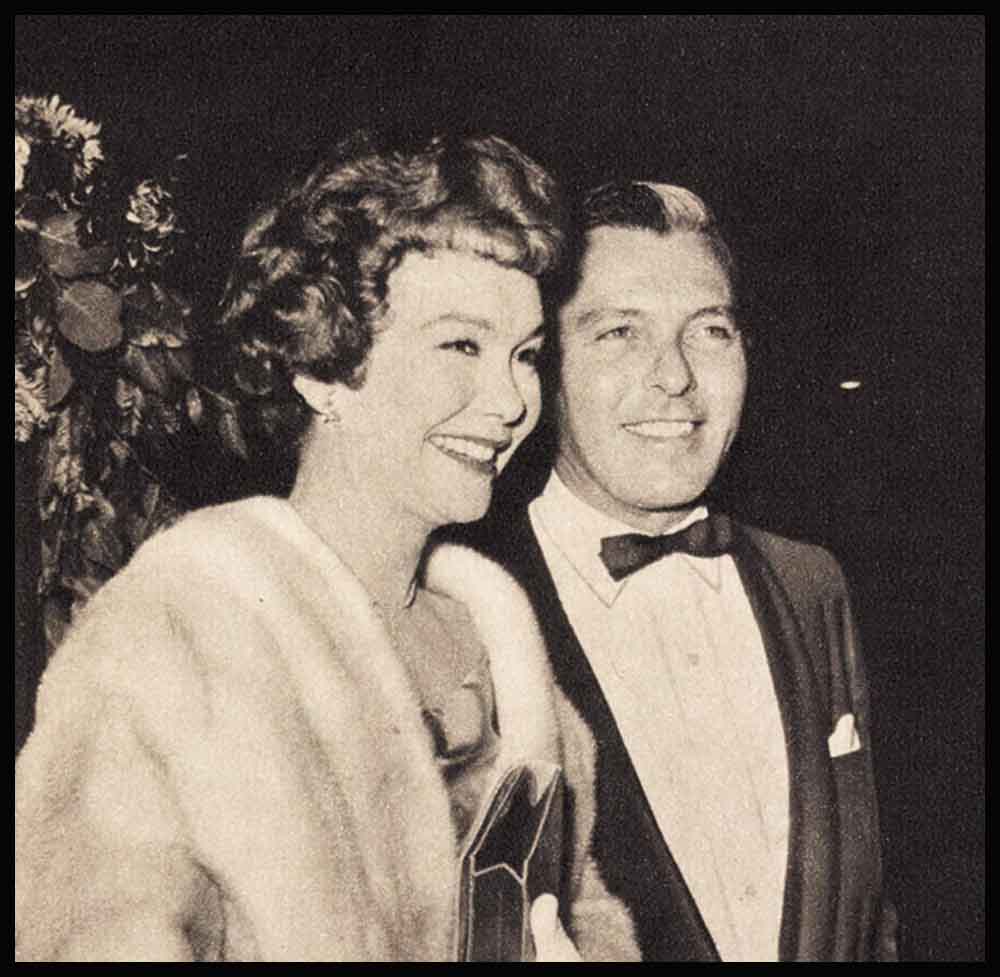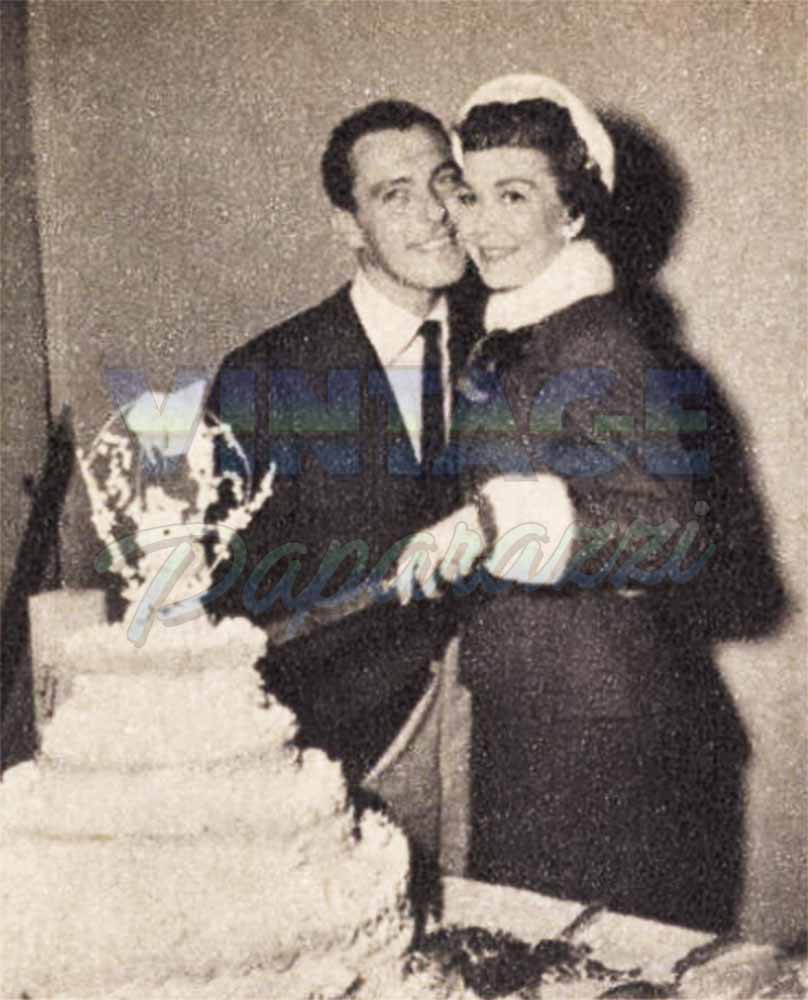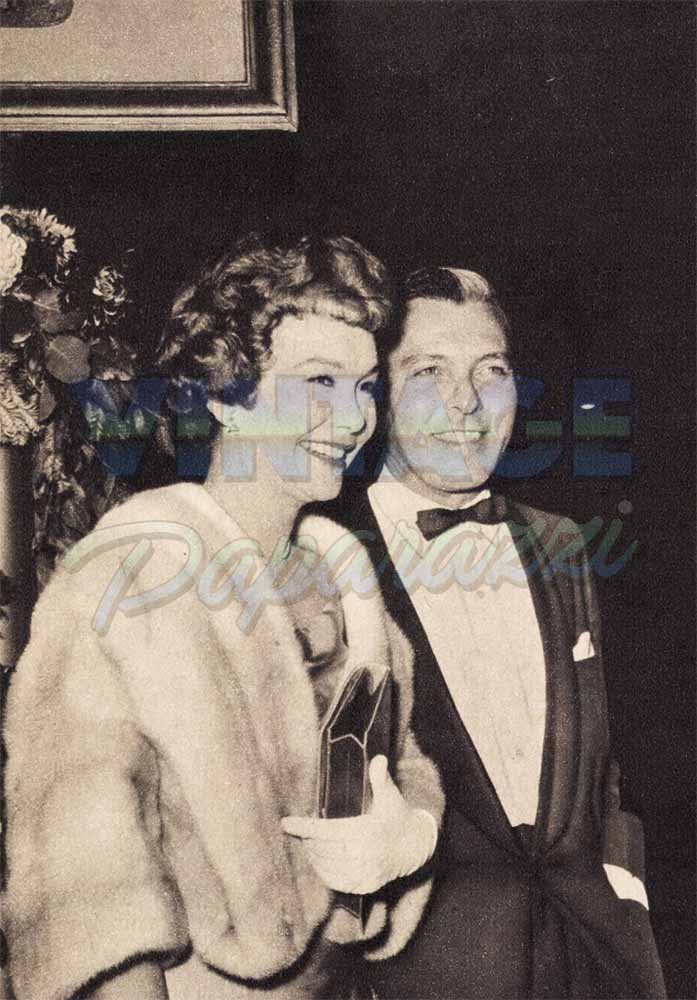
Love Is Lovelier The Second Time Around
It was Friday night, the tenth of March. The members of the orchestra in the crowded Star- light Room of the Beverly Hilton Hotel grinned at one another when their leader Freddie Karger gave them the nod to start In The Cool, Cool, Cool Of The Evening. They grinned because they knew that song had a special meaning—it meant Freddie’s ex-wife, Jane Wyman, was in the room. You see, Janie had recorded that song several years ago with Bing Crosby and it was a big hit. To Freddie, it became Jane’s song and his way of letting her know he was thinking of her.
The boys in the orchestra knew something else about their leader that Hollywood didn’t know. They knew Freddie was seriously courting Jane again. Courting the woman he had married in 1952 and divorced in 1954.
From 1954 to 1961 makes seven years by any man’s reckoning. During that seven years, Freddie never seriously dated another girl and Jane dated few men. They had traveled a long, lonely road over those years. But now it was over. For tomorrow, the very next day, they would be married in Newport Beach, California in the church of their faith. And unlike their photographer-crowded elopement to Santa Barbara in 1952, this wedding would be quiet, ever-so-quiet. There would be no swingin’ party after the ceremony. Instead, Freddie and Jane would go to mass—to- gether—then return to his small Beverly Hills apartment to take up their life to- gether. Their weekends would be spent at Jane’s lovely seaside hide-a-way in Newport.
And what about those seven years and the love that lived through them? Why did they fail in love back in 1952? Why did Jane divorce him in 1954? What made her return to him? Yes, they are all logical questions and there are logical answers for them. But to understand them better we must go back to the 1930’s when a bright-eyed little girl hit Hollywood.
Jane was Sarah Jane Fulks then, and her adoring mother thought—and rightly so— that her daughter was prettier and brighter and more talented than the average little girl. Unfortunately, the casting directors around Hollywood didn’t agree. Rejected, Sarah Jane and Mama went back to their little grey home in the mid-west.
About six years later, Sarah Jane turned up again in Hollywood. In the interim, she had acquired dancing and singing experience, a figure that turned men’s heads, a face the camera adored and a new name—Jane Durrell. Warners was signing cuties by the dozens—and they signed Jane.
Nobody at the studio had a crystal ball. They had no idea that this cutie named Durrell would become Jane Wyman and win an Academy Award in 1948 for Johnny Belinda. Neither did they know that in the same year she would lose her baby, and divorce her husband, Ronald Reagan, known then as “The All American Boy.” Of course, they didn’t know either that when she next married Freddie Karger and reporters referred to him as her second husband—they would be wrong.
Jane’s marital record has some mystery about it. There was a man named Eugene Wyman. What became of him and why is not a matter of record. What is a matter of record is that by 1938, Jane was married to and divorced from Myron Futterman. Mr. Futterman was a dress manufacturer, and maybe it was he who taught Jane about clothes. When she first arrived in Hollywood she wore more buttons and beads than a Zulu Princess. By the time she met Ronnie Reagan on the Warner lot, she was as chic and well-groomed as a gal could be.
As sophisticated as she appeared on the outside, Jane was confused within. She knew there was a thing called religion, but it barely touched her life. Her philosophy on love was almost juvenile. To her love was a toy, a thrill, the most important source of happiness. That it could be much, much more—a sharing, a giving, a spiritual human partnership, Jane had yet to learn. And like most women, she learned it through heart- break and suffering.

She didn’t learn heartbreak and suffering from Ronnie Reagan. In fact, he learned it from her.
From the day of their marriage in 1940 till the day of their divorce in 1948, the Reagan-Wyman love story was Hollywood’s favorite. When their first child was born January 4, 1941, Maureen Elizabeth Reagan was Hollywood’s princess. On March 18. 1945, a son Michael Edward arrived. Ronnie went into the Army and served four years. Jane stopped being a cutie-pie both off screen and on. She clicked in Princess O’Rourke and went dramatic in The Lost Weekend which won an Oscar as 1945’s best picture. In 1947 she played Greg Peck’s wife in another film of Academy-Award calibre, The Yearling. In that film she also played the mother of an adolescent boy—a pretty daring thing for a young actress. But Jane thought, “Why shouldn’t I play a mother, İd real life I have two children.”
When 1948 rolled around, Jane was about to be the mother of three—but her premature baby lived only one day.
Could it have been the loss of the baby that killed Jane’s love for Ronnie? Could it have been her Johnny Belinda co-star, Lew Ayres? Was it the Oscar she won for that film? Was it one of these things—or all of them put together?
In the divorce court Jane said it was politics that had broken up her marriage. She was granted a divorce June 28, 1948, on the grounds of mental cruelty.
After the divorce, she moved from the ranch she shared with Ronnie and the children to a chic house in chic Bel-Air. It was in that house that she learned about loneliness and heartache.
Before the divorce, Jane had flippantly said people would hold her divorcing Ronnie against her. And she was right. The divorce stirred up quite a bit of angry dust. After all, Ronnie had sewed his country, served his profession as president of the Screen Actors’ Guild, and was interested in city and state politics. And besides, Ronnie deeply loved Jane.
So in that chic house in chic Bel-Air, Jane, a free woman, found her free time much too free. If she had been attracted to the deeply religious Lew Ayres during the filming of Johnny Belinda, once the film was over she realized she might as well forget him.
So, with all this free time on her hands, Jane began thinking seriously of religion.
It was then that Greg Bautzer, a lawyer-man-about-town, came into her life. And like Lana Turner, Joan Crawford, Carole Landis and Ginger Rogers before her, Jane forgot everything but Greg. All Hollywood grinned at the thought of Bautzer having dropped Ginger for Jane. Ginger, you know, had been Mrs. Lew Ayres.
Bautzer completely charmed the ladies he dated. Jane was no exception. She gave out those “We’re just good friends,” statements when asked about him . . . just as Ginger and Joan and the others had done before her—just as Greg’s girls would continue to do until he dated one named Dana Wynter.
Next came a 26-year-old man named Travis Kleefeld. Today, he’s known as singer Tony Travis, but early in 1952, when Jane announced she would wed him, he was a wealthy young man working in his family’s business of building houses. Hollywood was shocked at the announcement—Jane was 12 years older than her fiance. Four months later the engagement was broken.

Again Jane was depressed. She’d done a very sombre film, The Blue Veil. It won critical acclaim but little else. Her children were away at school and as she walked around her big, big house, the silence was almost unbearable. She wanted help, but she didn’t know where to find it.
Then one night Freddie Karger brought her home from a benefit. And, as every woman knows, no matter what problems a woman has, let a man come into her life and she thinks everything’s solved.
Actually, Freddie wasn’t a new man to Jane. They’d known each other very casually before Jane married Ronnie and Freddie married Patti Sachs, a law student. In the restricted social circles of Hollywood, the paths of an Academy-Award winning star and a musical arranger seldom cross.
It was a film, prophetically titled Love Song, that brought them together. During the filming, Jane had agreed to sing at a benefit show, Karger was then under contract to Columbia and handling the musical chores for the film. It was natural that he go to the rehearsal to supervise Jane’s song. After rehearsal, he took her home.
Jane was delighted to be with an old friend with whom she could completely relax. She was even pleased when he cut down Santa Monica Boulevard—the shortest way home. It was then she spied Barney’s Beanery—a Hollywood landmark since 1915 or thereabouts. When Jane saw the big sign, a wave of nostalgia swept over her.
“I’m hungry,” she announced.
“So am I. You want to go to Romanoff’s?” asked the nice Mr. Karger.
“Would you think I was crazy if I said I’d like to stop right here at Barney’s? Freddie, do you remember how the gang used to come here?”
“Sure,” he said. “The hamburgers were a dime, the coffee a nickel. We’d talk all evening for twenty cents—tip included.”
Jane sighed, “It’s a shame none of us comes here. . . .”
“I come,” Freddie said. “The food is still terrific and so’s the talk. It may set me back ninety cents to feed you—but I m game if you are!”
Jane laughed and suddenly she realized it had been a long, long time since she’d laughed that freely.
“Barney won’t remember me,” she said. “The last time I was here was 15 years ago—and I was a blonde.”
Barney did recognize her and insisted she have the biggest steak on the house. Later over coffee the three of them began to reminisce.
“Remember that vaudevillian with all the teeth we used to call the runaway horse? His name was Fred something. What ever happened to him, Barney?”
“He was Freddie’s uncle,” Barney said.
Beet-faced, Jane turned to Freddie and said, “I guess you’d better take me home now.”
He did.
He wasn’t at the studio the next day. He wasn’t at the benefit that night. He wasn’t at the studio the day after that, either. Jane kept telling herself there wasn’t any reason for him to be. Yet . . . she hoped she’d run into him. . . .
That night she went home to her big empty house—empty except for Carrie, the wonderful maid she’s had since her marriage to Ronnie. Carrie had planned a lovely dinner and wondered if maybe Jane wanted to call Eve Arden and invite her over to share it. As Jane walked to the phone, it rang.
“Could I get you to come out to dinner tonight—Barney’s or otherwise?” asked Freddie. “Would you come and not drag my relatives into the conversation?”
That was the start of a courtship unlike any Jane had ever experienced. It wasn’t glamorous, or exciting or filled with long talks of politics or war. It was as unpretentious as a glass of ice-cold milk on a hot summer day. Jane and Freddie talked of their profession, their family, and their hopes and heartaches. She discovered Freddie had moved back with his mother and sister after his divorce from Patti. His daughter Terry lived with them, too—and she was exactly Maureen’s age.
They dined together almost every evening. Quietly, Freddie checked Jane’s shooting schedule and knew when she must be home early for studio calls the next morning. 11- year-old Maureen loved Freddie, but what pleased Jane most was that her son Mike did, too. Freddie was the first of her dates 7-year-old Mike liked. The two Reagan children also liked Terry Karger.
Love Song was scheduled to wind up on October 31, 1952. On October 30, they looked across the sound stage and knew they were in love. Two days later amid photographers galore they were married in Santa Barbara. The reception was big and wonderful. Just as the judge pronounced them man and wife, a wire arrived. It said, “WE’RE SO HAPPY TO HAVE OUR MOMMY AND DADDY TOGETHER.” It was signed Maureen, Mike and Terry.
That November 2, 1952, Jane and Fred knew nothing could part them. On December 7, 1954, Jane Wyman received the divorce she requested, and both of them knew nothing could bring them back together.
Besides, she had her work. She was announced for a TV series— The Jane Wyman Show. It would keep her busy, very busy.
Unfortunately (or maybe fortunately!), the TV show didn’t click. She didn’t get as many film roles as she once had, either. Her children were growing taller and beginning to lead a life of their own. And she, Jane Wyman, had lots of time on her hands.
Only she didn’t want it. She was so terribly lonely she didn’t know what to do with herself. Once again she was strong enough and honest enough to see she could use help. She wondered who on earth she could turn to—until one day she realized the help she needed wasn’t on earth at all.
That was when she turned to the Catholic Church which, in a way, was also turning back to Freddie Karger. Freddie had been born and brought up a Catholic. He wasn’t a devout Catholic because he’d married and divorced outside the church. And then he’d married Jane, a divorcee—outside his church. But faith ingrained in childhood is seldom completely forgotten. Freddie’s faith wasn’t gone—it was just far, far back in his mind.
With Jane it was quite different. Regular church attendance was new to her. The disciplines of the Catholic Church were new to her. But so was the feeling of internal peace. Loneliness began to leave her for now she knew she was not alone. Finally, she began to take Catholic instruction.
The instruction went on for many months. She saw few people except Maureen and Mike. Maureen began to talk about wanting to go to New York to be on her own. A few months before, Jane couldn’t have endured the idea of letting her go. Now, because of her faith in God, she had the strength to let her daughter find her own way.
A year went by, then another and another. Jane began to know herself and as she did, she became aware of how demanding she had been with the men who had loved her. Her values changed. The constant busyness she once yearned for suddenly meant nothing. She now knew the difference between solitude and loneliness.
In addition, she found her wish to give love was growing. Previously, she had wanted to receive love, then share it. But now she knew the meaning of the words: It is more blessed to give than to receive.
Thus, shyly at first, and then with increasing trust and happiness, she and Freddie began seeing each other in 1959. Freddie had changed, too, she soon realized.
They did not immediately discuss the fact that neither of them had married or fallen in love with anyone else since 1954. They didn’t discuss it because both of them were a little frightened of using the word love.
They had very quiet dinners at her house in Newport or at Freddie’s mother’s place. They discussed their children and little by little they began to talk about their faith—Freddie’s old, nearly forgotten faith and Jane’s new, radiant, mature faith. Quietly and in sincere humility, they began going to mass together. As the days passed they realized they were in love again—and their love was lovelier the second time around. Now they had one tender ambition—to be able to marry in their mutual faith.
This was not easy. The Catholic Church, in its established wisdom, put them to many a test. Waiting was one of them and it was the hardest test of all for the naturally impulsive Jane. When they were finally told they could wed, Jane and Freddie genuinely recognized that this was definitely their first marriage—a holy covenent which they would revere and maintain. A marriage like their love—that would be far, far better and last forever—second time around.
—BY RUTH WATERBURY
It is a quote. MOTION PICTURE MAGAZINE JUNE 1961




